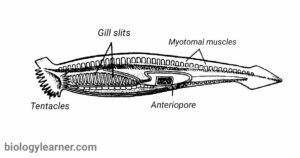Phylum Ctenophora and Phylum Cnidaria were in one phylum (phylum Coelenterata) in the early days. Later Coelenterata was divided into two separate phyla one is Cnidaria and the other is Ctenophora.
In the phylum Ctenophora, animals are bearing special forms of the comb. The animals are commonly known as comb jellies.
The word Ctenophora is made up of two Greek words ktenos and phoros.
“Ktenos = comb and Phoros = to bear “
Most of the animals are planktonic, but a few species are epibenthic in this phylum.
Definition of Ctenophora
Ctenophores are diploblastic ovoid transparent biradially symmetrical animals having organized digestive systems and comb plates.

Characteristics of Ctenophora
- Body biradial symmetrical.
- There are eight plates located at equal distances from the body.
- Generally, they have two tentacles.
- Colloblast cells are present in the tentacles.
- They have complete digestive ducts in their body.
- There is a mouth hole in the oral cavity and two small anal pores in the aboral cavity.
- The sense organs are located in the aboral cavity.
- The polyp phase is absent in their life cycle.
- There is no alternation of generation.
- The animals are bisexual.
- The nervous system is in the form of a lattice.
- Animals of Ctenophora are marine and non-colonial.
- Identifying characters of Ctenophora:
- Comb plate: There are eight comb plates located at equal distances around the body.
- Tentacles: Colloblast or lasso cells are present in the tentacles.
- Digestive system: In the body complete digestive duct is present.
- Alternation of generation: There is no alternation of generation in the life cycle of Ctenophores.
- Habitat: In this phylum all the animals are marine.
Identification Characters
- Comb plate: There are eight comb plates located at equal distances around the body.
- Tentacles: Colloblast or lasso cells are present in the tentacles.
- Digestive system: In the body complete digestive duct is present.
- Alternation of generation: There is no alternation of generation in the life cycle of Ctenophores.
- Habitat: In this phylum all the animals are marine.
Examples
Some common animals of the phylum ctenophores are Hormiphora, Ctenoplana, Beroe, Cestus, Pleurobranchia, etc.



